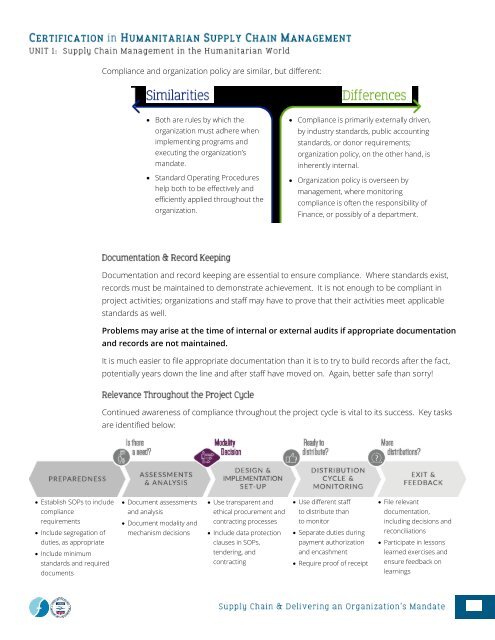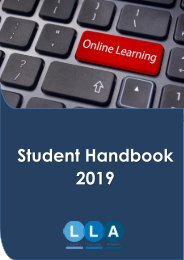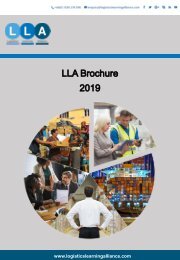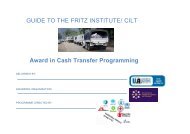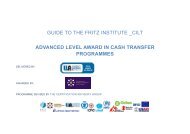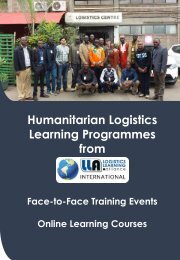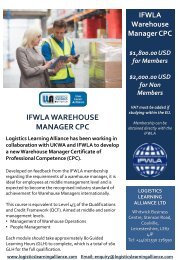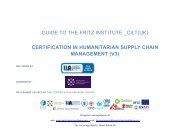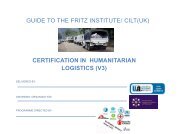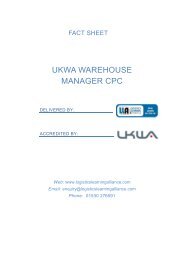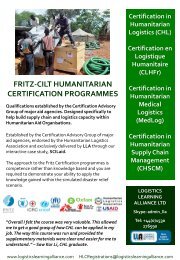CHSCM 3.0 - Unit 1 - SCM in the Humanitarian World
Learning Materials for Unit 1 of the Certification in Humanitarian Supply Chain Management (CHSCM).
Learning Materials for Unit 1 of the Certification in Humanitarian Supply Chain Management (CHSCM).
You also want an ePaper? Increase the reach of your titles
YUMPU automatically turns print PDFs into web optimized ePapers that Google loves.
Compliance and organization policy are similar, but different:<br />
• Both are rules by which <strong>the</strong><br />
organization must adhere when<br />
implement<strong>in</strong>g programs and<br />
execut<strong>in</strong>g <strong>the</strong> organization’s<br />
mandate.<br />
• Standard Operat<strong>in</strong>g Procedures<br />
help both to be effectively and<br />
efficiently applied throughout <strong>the</strong><br />
organization.<br />
• Compliance is primarily externally driven,<br />
by <strong>in</strong>dustry standards, public account<strong>in</strong>g<br />
standards, or donor requirements;<br />
organization policy, on <strong>the</strong> o<strong>the</strong>r hand, is<br />
<strong>in</strong>herently <strong>in</strong>ternal.<br />
• Organization policy is overseen by<br />
management, where monitor<strong>in</strong>g<br />
compliance is often <strong>the</strong> responsibility of<br />
F<strong>in</strong>ance, or possibly of a department.<br />
Documentation and record keep<strong>in</strong>g are essential to ensure compliance. Where standards exist,<br />
records must be ma<strong>in</strong>ta<strong>in</strong>ed to demonstrate achievement. It is not enough to be compliant <strong>in</strong><br />
project activities; organizations and staff may have to prove that <strong>the</strong>ir activities meet applicable<br />
standards as well.<br />
Problems may arise at <strong>the</strong> time of <strong>in</strong>ternal or external audits if appropriate documentation<br />
and records are not ma<strong>in</strong>ta<strong>in</strong>ed.<br />
It is much easier to file appropriate documentation than it is to try to build records after <strong>the</strong> fact,<br />
potentially years down <strong>the</strong> l<strong>in</strong>e and after staff have moved on. Aga<strong>in</strong>, better safe than sorry!<br />
Cont<strong>in</strong>ued awareness of compliance throughout <strong>the</strong> project cycle is vital to its success. Key tasks<br />
are identified below:<br />
• Establish SOPs to <strong>in</strong>clude<br />
compliance<br />
requirements<br />
• Include segregation of<br />
duties, as appropriate<br />
• Include m<strong>in</strong>imum<br />
standards and required<br />
documents<br />
• Document assessments<br />
and analysis<br />
• Document modality and<br />
mechanism decisions<br />
• Use transparent and<br />
ethical procurement and<br />
contract<strong>in</strong>g processes<br />
• Include data protection<br />
clauses <strong>in</strong> SOPs,<br />
tender<strong>in</strong>g, and<br />
contract<strong>in</strong>g<br />
• Use different staff<br />
to distribute than<br />
to monitor<br />
• Separate duties dur<strong>in</strong>g<br />
payment authorization<br />
and encashment<br />
• Require proof of receipt<br />
• File relevant<br />
documentation,<br />
<strong>in</strong>clud<strong>in</strong>g decisions and<br />
reconciliations<br />
• Participate <strong>in</strong> lessons<br />
learned exercises and<br />
ensure feedback on<br />
learn<strong>in</strong>gs


